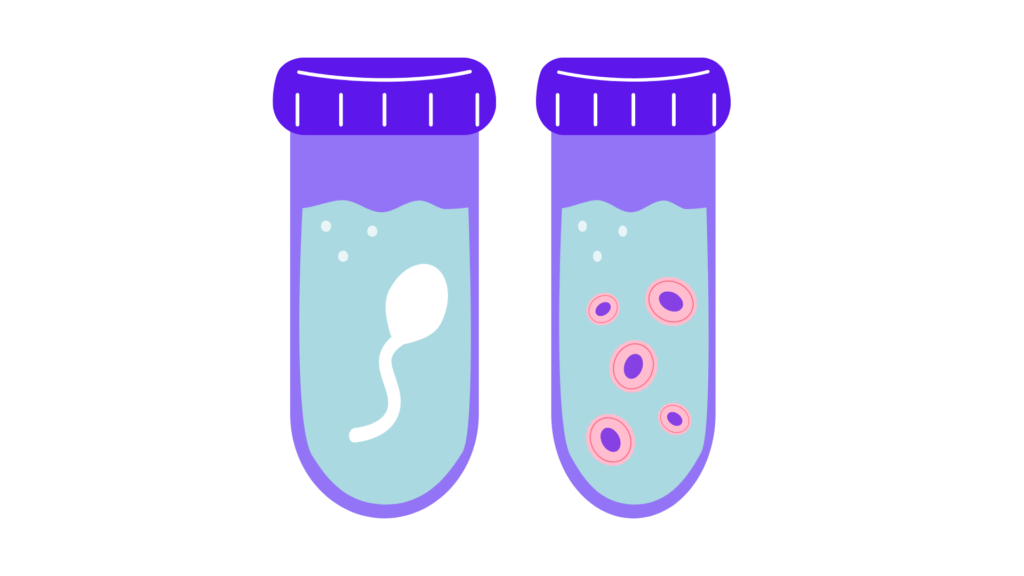In Vitro Fertilization
Learn all about IVF Process, IVF Concerns and IVF Success Rate
Published : 29/04/2024
Last updated: 21/05/2024
Maybe you’ve ben trying to get pregnant for a while now, and all other fertility treatments have failed and you’re thinking of pursuing in vitro fertilization (IVF).
Sometimes however, doctors recommend starting with IVF treatment. This could be because of a lot of reason, for example -an issue with your fallopian tube or with your follicle growth, male infertility, maybe you have to get an egg donor or because you had cryopreserved (frozen) your eggs previously or maybe go for a gestational carrier (a person commissioned by the parents to carry their baby in the womb, this person is not genetically linked to the baby).
Understanding the steps of IVF process is essential if you’re thinking of going through it. This is because this journey can be both exciting and stressful and the more you know about it, the more in control you’ll feel as you embark on it.
A Gist of the Entire IVF Process
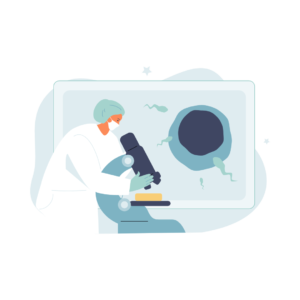 IVF involves many complex steps and is an effective form of assisted reproductive technology (ART). Here is a a gist of it for better understanding:
IVF involves many complex steps and is an effective form of assisted reproductive technology (ART). Here is a a gist of it for better understanding:
The process starts with stimulating the ovaries by injectable/oral fertility drugs.
Next these eggs are retrieved via transvaginal ultrasound-guided needle.
The eggs are then placed in a petri dish with specially washed sperm cells.
If everything is done correctly some of these eggs will be fertilized by a sperm in the petri dish.
One-two of those healthy embryos will be transferred to the uterus on average.
This process to takes a few weeks.
Success rates for IVF
To understand the success rates of IVF, lets first have a glimpse of success rates for normal pregnancy over a period of 12 months:
Average chances of Getting Pregnant Naturally
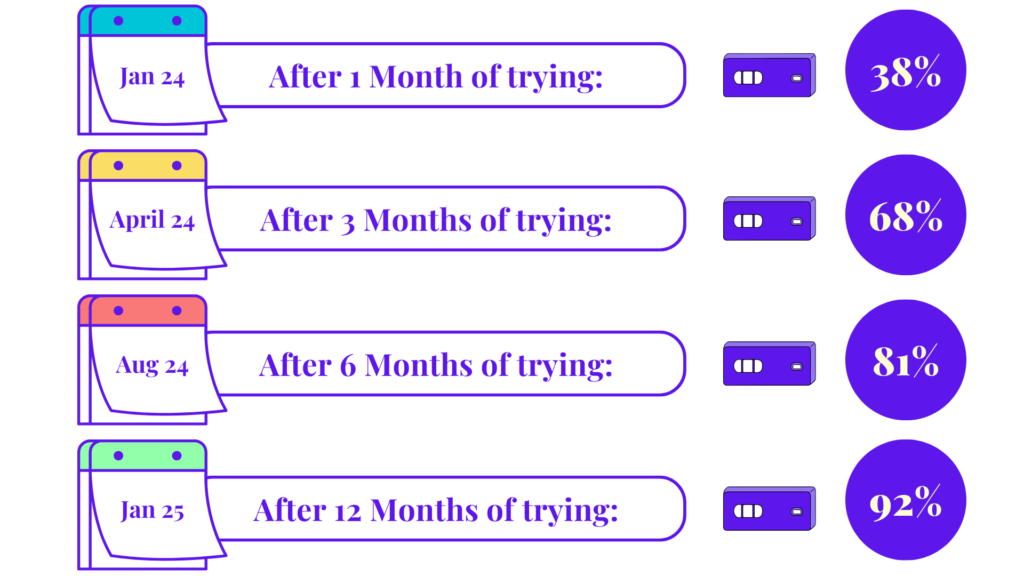
Now let see the probability of IVF live-birth -a study observed that 156,000 women, aged between 18 -55 with an average infertility of 4 years, had 29.5% probability of giving live-birth in the first cycle -a ‘cycle’ as an episode starting from ovarian stimulation to embryo transfers.
This is comparable to the 38% chance of getting pregnant naturally, after the first month of trying. So IVF is statistically successful. However, the best results came after repeated treatment cycles (average 6 cycles, over 2 years) and success rate went up to 65,3%.
Your fertility expert can’t assure you if the treatment will work, but considering all factors for example, your age and reason for infertility, they should be able to have an idea of the possibility of success.
Concerns with IVF
IVF is generally safe, but as with any medical procedure, there are risks. Your doctor should explain all possible side effects and risks before you begin.
Ovarian Hyperstimulation Syndrome (OHSS)
OHSS occurs in 10% of women whose ovaries are stimulated for IVF treatment. It causes the ovaries to swell and become painful. It is an exaggerated response due to injectable hormone medications. Symptoms may occur a few days/weeks after ovulation or IVF egg retrieval.
For most people, symptoms are mild, and they recover easily. For a small percentage, OHSS can be more serious and may require hospitalization. Less than 1% of people going through egg retrieval will experience blood clots or kidney failure due to OHSS.
Cramping, Discomfort, or Infection
Egg retrieval may cause cramping and discomfort during or after the procedure. Rare complications include accidental puncture of the bladder, bowel, or blood vessels, pelvic infection, or bleeding from the ovary or pelvic vessels.
If pelvic infection does occur, you’ll be treated with intravenous antibiotics. In rare cases of severe infection, the uterus, ovaries or fallopian tubes may need to be surgically removed.
The embryo transfer also may cause mild cramping during the procedure. Rarely, people will experience cramping, bleeding, or spotting after the transfer. In very rare cases, infection can occur.
Multiple Pregnancies
The risk of twins, triplets, or more pregnancies can be risky for both the babies and the parent. It’s important to discuss with your healthcare provider how many embryos to transfer, as transferring more than necessary will increase your risk of conceiving twins or more.
Embryos are transferred after they are tested with, Preimplantation Genetic Diagnosis (PGD) – an early form of prenatal genetic diagnosis where abnormal embryos are identified, and only genetically normal embryos are used for implantation.
Birth Defects
Some research has found that IVF may raise the risk of some very rare birth defects, but the risk is still relatively low.
Research has also found that the use of medications in certain cases of male infertility, may increase the risk of infertility and some sexual birth defects for male children. This risk, however, is very low (less than 1%).
Step-by-Step Breakdown of IVF Procedures
This section is explains all the steps of IVF in brief and is meant to provide an overview of the entire proccess.
IVF Step 1:
Consultation and Planning for Treatment
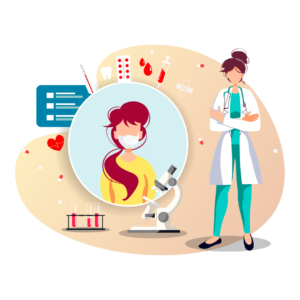
The treatment starts by taking control of your ovulation cycle and OHSS.
Ovulation cycles are tracked by ovulation predictor kit or basal body temperature.
OHSS is controlled by medications to stop hyperstimulation of ovarian cysts.
IVF Step 2:
Treatment Cycle Starts
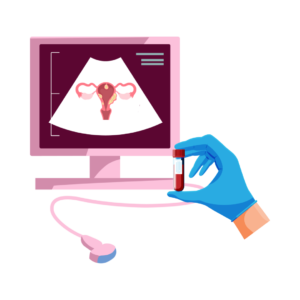 The first-day tests start with your period, your doctor will want to see your baseline bloodwork and transvaginal ultrasound.
The first-day tests start with your period, your doctor will want to see your baseline bloodwork and transvaginal ultrasound.
The bloodwork is to check estrogen (estradiol) levels to make sure your ovaries are ‘sleeping’ – the intended effect of medications.
The ultrasound checks ovary sizes and for ovarian cysts and helps understand if the process can be carried further.
The good news is that most of these cysts resolve on their own with time. So, making your ovaries ‘sleep’ with medications reduces the chances of OHSS.
IVF Step 3:
Ovarian Stimulation and Monitoring
 Monitoring your ovarian stimulation is the next step. You’ll start dealing with injectables and the doctors will require frequent bloodwork and ultrasounds.
Monitoring your ovarian stimulation is the next step. You’ll start dealing with injectables and the doctors will require frequent bloodwork and ultrasounds.
All these to monitor your estradiol levels and Oocyte growth -Oocytes are the eggs inside the follicle of your ovaries.
Monitoring Oocyte growth is essential because it also helps decide dosages of your medications.
IVF Step 4:
Final stages of Follicle Maturation
 Before retrieving eggs, they must be fully matured. The final stages of growth and development is triggered by a specific medications such as hCG.
Before retrieving eggs, they must be fully matured. The final stages of growth and development is triggered by a specific medications such as hCG.
Timing this shot is vital – if its too early, the eggs will not mature enough and if its too late the eggs will be ‘too old’ and won’t fertilize properly.
Timing is based on follicles growth and estradiol levels – daily ultrasounds and frequent bloodwork are done to time it right.
A lot of other factors are kept in consideration before the final trigger shot – risk of OHSS, premature ovulation, follicle growth is not satisfactory and maybe IVM is required from here onwards.
These factors do influence the decision to cancel the process if required. Cancellation is common, happening between 10% to 20% of IVF treatment cycles.
IVF Step 5:
Retrieving Eggs
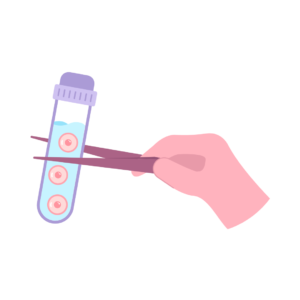 As medications start working after 34 -36 hours of the trigger shot, the egg retrieval process begins.
As medications start working after 34 -36 hours of the trigger shot, the egg retrieval process begins.
Transvaginal ultrasound is used to guide a needle to your ovaries and gently suck out the oocytes within your follicles into the needle, this process is also know as aspiration of follicles.
Each follicle houses a single oocyte and usually doctors collect 8-15 oocytes on an average. Once the collection process is done the oocytes are sent to embryology lab for fertilization.
IVF Step 6:
Fertilization of the eggs
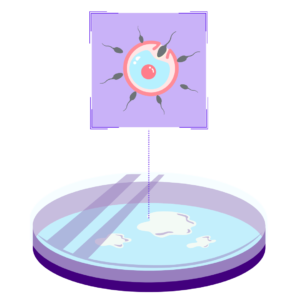 Usually your partner is required to provide semen samples on the same day/ a day before the egg retrieval. Because fertilization with collected oocytes must happen within 12 -24 hours.
Usually your partner is required to provide semen samples on the same day/ a day before the egg retrieval. Because fertilization with collected oocytes must happen within 12 -24 hours.
The semen sample is put through a special washing process to separate the sperm from seminal fluid. The embryologist will collect healthy sperms and put a few thousand of them in a petri dish with a single oocyte.
There can be multiple petri dishes, depending on the number of collected oocytes and all these are put inside a special incubator for 12-24hrs for fertilization to take place.
IVF Step 7:
Transferring the Fertilized Eggs
 After a couple of days the healthiest of fertilized eggs or embryos are identified by the embryologist in some cases PGD is performed at this stage.
After a couple of days the healthiest of fertilized eggs or embryos are identified by the embryologist in some cases PGD is performed at this stage.
Upon discussion with your doctor a number of these healthy embryos will be transferred to your uterus (maximum 5). If you have more healthy embryos you might also be suggested to cryopreserve them, so they can be used in the next cycle if this one is not successful.
Once all decisions are made, the embryo transfer process begins with a thin tube or a catheter passed through your cervix and the embryos are then transferred inside your uterus with a small amount of fluid.
IVF Step 8:
Waiting for next two weeks
 After completion of transfer process you’ll be asked to rest for a couple of hours and then sent home and asked to wait for two weeks.
After completion of transfer process you’ll be asked to rest for a couple of hours and then sent home and asked to wait for two weeks.
You’ll also be asked to use progesterone supplement, this helps to support the uterine lining and helps in embryo implantation.
These two weeks will have no activity and can be a difficult time emotionally, since there won’t be much happening as compared to the weeks before where you had to visit the hospital every other day.
It is preferable to stay calm and relaxed without putting much stress overthinking on what would be the outcome.
IVF Step 9:
Tests and Follow-Ups

Around 9-12 days after the embryo transfer you’ll be asked to take a blood test and a test to check your progesterone levels and this can be repeated every couple of days.
If the test is positive then you’ll need to take progesterone for several weeks and your doctor will recommend with occasional bloodwork and ultrasounds to monitor the pregnancy.
A Gentle Nudge from Mammas Journey
The chances of a negative pregnancy after 14 days of embryo transfer is a possibility one must consider… If the test come out as negative it is between you, your partner and your doctor to decide what to do next, whether to go for another cycle….
It is always disheartening if a cycle fails, but don’t be afraid to try again, since repetitions of these cycles yield greater chances of getting pregnant.

